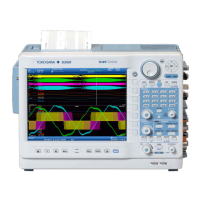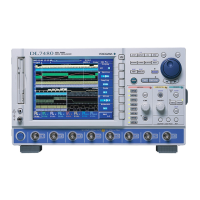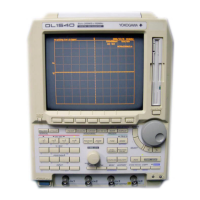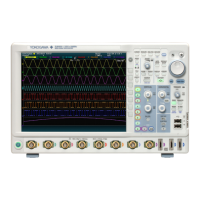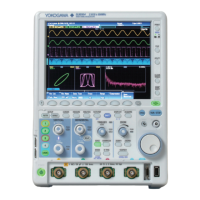7-3
IM DLM6054-01EN
Waveform Acquisition and Display
7
8
9
10
11
12
13
14
15
16
17
18
Index
App
Trigger Mode (Trig Mode)
You can select one of the following conditions for updating the displayed waveforms. You can also set
the trigger mode by pressing the MODE key (see section 6.1 for details).
Auto, Auto Level, Normal, and N Single
High Resolution Mode (High Resolution)
Bandwidth filtering reduces data quantization noise and enables the DL6000/DLM6000 to produce
high resolution data that is greater than 8 bits. Normally, data is stored to the acquisition memory using
8 bits, and higher resolution data is converted to 8-bit data before it is saved. When you turn high
resolution mode ON, the DL6000/DLM6000 saves data using 16 bits (up to 12 effective bits).
If you turn high resolution mode ON, the maximum record length will change from 6.25 to 2.5 Mpoint.
If you turn high resolution mode ON when the bandwidth limit is set to FULL, the bandwidth limit will
automatically change to 200 MHz.
Note
High Resolution mode does not apply to logic waveforms.
Interleave Mode (Interleave)
When you turn Interleave mode on, the number of usable channels decreases, but you can set the
sample rate to 5 GS/s in real-time sampling mode (2.5 GS/s in high resolution mode).
*
When you set the sample rate to 5 GS/s(2.5 GS/s in high resolution mode), CH2 and CH4
automatically become unusable.
*
* This sample rate applies to the DL6054, DL6104, DLM6054, and DLM6104. On the DL6154, the
sample rate is 10 GS/s (5 GS/s in high resolution mode).
Sampling Mode (Sampling Mode)
The DL6000/DLM6000 samples data using a 2.5 GS/s A/D converter, so the maximum sample rate in
normal sampling mode (real-time sampling mode) is 2.5 GS/s.
*
If you decrease the time axis setting when measuring fast phenomena, the sample rate will reach its
maximum rate (2.5 GS/s) at a certain point.
*
If you decrease the time axis setting further, the number of
displayed points decreases (the display record length decreases).
The DL6000/DLM6000 has two modes for interpolating additional points between data points. Select
one of the interpolation modes when you want to make measurements by setting a sample rate that is
higher than the real-time sampling mode’s maximum sample rate (2.5 GS/s).
*
• Interpolation mode:
The DL6000/DLM6000 interpolates between data points using the (sinx)/x function. This mode is
effective for single-shot signals.
• Repetitive sampling mode:
The DL6000/DLM6000 interpolates through random sampling. This
mode is effective for repeating signals.
* This sample rate applies to the DL6054, DL6104, DLM6054, a
nd DLM6104. For the DL6154, the
sample rate is 5 GS/s.
Relationship between the Time Axis Setting, Record Length, and Sample Rate
The relationship between the time axis setting, record length, and sample rate is as follows:
When the record length (display record length) and the time axis are set so that the sample rate is
at the maximum rate, if you decrease the time axis setting further, the record length (display record
length) is reduced.
Sample rate = Record length/(time axis setting [s/division] × 10
[divisions])
7.1 Setting Conditions for Waveform Acquisition

